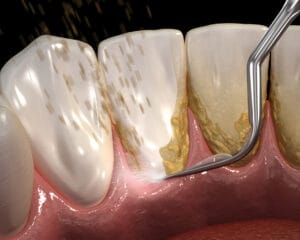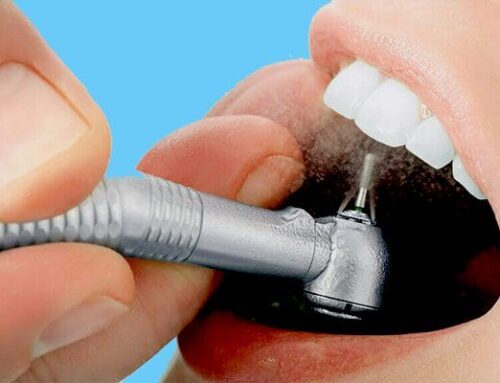
Air Polishing: A Gentle and Effective Innovation
In contrast, air polishing represents a paradigm shift in dental cleaning technology. This method uses a special handpiece to send a controlled stream of compressed air, water, and fine abrasive particles (usually traditional sodium bicarbonate) toward the tooth surface. The pressurized mixture effectively dislodges and removes surface stains, soft deposits, and bacterial biofilm with remarkable efficiency.
Unlike traditional cleaning, air polishing does not involve direct metal-to-tooth contact, resulting in a more comfortable experience for many patients. It also allows hygienists to reach challenging areas such as around orthodontic appliances, orthopedic brackets, dental implants, and deep fissures, where traditional scalers might struggle to reach effectively during dental cleaning procedures. The procedure is significantly faster than manual scaling, allowing for more efficient dental appointments and less time in the chair for patients.
What are the advantages of air polishing?

The ultrasonic teeth cleaning machine effectively removes calculus and plaque, contributing to improved oral hygiene.
The benefits of air polishing extend well beyond basic cleaning efficiency. One of the most notable advantages is the significant reduction in patient discomfort. Without the scraping sensation of metal instruments against teeth and gums, patients report less sensitivity during the procedure. This makes air polishing particularly valuable for individuals with periodontal disease who require frequent maintenance visits.
Another substantial benefit is its superior stain removal capability. Air polishing excels at eliminating extrinsic stains caused by coffee, tea, tobacco, and red wine. It restores the natural color and luster of enamel more effectively than manual cleaning, often enhancing aesthetics without the need for whitening treatments.
Additionally, air polishing is an excellent tool for biofilm management. Dental biofilm harbors bacteria that contribute to cavities and gum disease. Air polishing disrupts and removes biofilm more comprehensively than manual techniques, potentially improving long-term oral health outcomes. Studies indicate that air polishing can significantly reduce bacterial load in periodontal pockets, helping control inflammation and disease progression.
It is also gentler on tooth enamel. Repeated manual scaling can, over time, contribute to minor enamel abrasion or root surface wear. Because air polishing uses a soft abrasive medium propelled at controlled pressure, it minimizes this risk while delivering thorough cleaning results.
What is the Role of Sodium Bicarbonate and Other Powders?
Sodium bicarbonate (baking soda) plays a pivotal role in the effectiveness of air polishing systems. This mild abrasive compound offers several advantages: its particle size and hardness are calibrated to effectively remove stains and plaque without damaging enamel or soft tissue. With a Mohs hardness of about 2.5, compared to 5 for enamel, sodium bicarbonate is safe for regular use.
 Its slightly alkaline pH (around 8.3) helps neutralize oral acidity, discouraging the growth of acid-producing bacteria and promoting a healthier oral environment. Furthermore, its high solubility prevents discomfort or tissue irritation after treatment.
Its slightly alkaline pH (around 8.3) helps neutralize oral acidity, discouraging the growth of acid-producing bacteria and promoting a healthier oral environment. Furthermore, its high solubility prevents discomfort or tissue irritation after treatment.
Modern practices may use alternative powders tailored to patient needs:
- Glycine powder – even gentler, suitable for subgingival cleaning and patients with sensitive teeth or implants.
- Erythritol powder is extremely fine and minimally abrasive, ideal for frequent periodontal maintenance.
- Calcium sodium phosphosilicate – provides remineralization benefits and helps reduce sensitivity post-treatment.
This customization allows hygienists to select the most appropriate powder based on clinical indications and patient tolerance.
Ultrasonic Scaling: Power and Precision
Ultrasonic scaling systems represent another leap forward in dental cleaning technology. These devices use high-frequency vibrations, usually between 25,000 and 50,000 Hz, to effectively break apart tough tartar and calculus buildup. Dental professionals often use air polisher systems like the EMS Air-Flow and Cavitron Prophy-Jet, which may incorporate a mixture of air and calcium sodium phosphosilicate for enhanced cleaning. These are among the most commonly used dental air polisher systems in clinical settings due to their efficiency and ability to deliver thorough, comfortable cleaning.
The mechanism of action combines mechanical vibration with cavitation, a process in which high-energy bubbles form and implode within the water spray, disrupting bacterial cell membranes and flushing debris away, including plaque biofilm. The instrument tip stays cool because water flows constantly, which stops heat from building up and makes cleaning better by constantly irrigating, as cited in studies available on Google Scholar.
Research consistently shows that ultrasonic scaling achieves outcomes equal to or better than manual scaling in removing subgingival calculus and disrupting oral biofilm, on subgingival surfaces, thereby improving gum health, while reducing treatment time by as much as 30–40%. The result is a faster, less tiring procedure for both the patient and the clinician.
How does dental air polishing compare with ultrasonic scaling?
Although both technologies serve the goal of thorough plaque and calculus removal, they differ in their primary function:
- Ultrasonic scaling targets dense deposits (calculus and tartar).
- Air polishing removes soft deposits, stains, and bacterial biofilm.
In modern practice, the two methods are often used in combination—ultrasonic scaling first to remove calcified buildup, followed by air polishing to smooth and disinfect surfaces. This complementary approach ensures the most comprehensive cleaning possible.
Recommended Frequency of Air Polishing
Air polishing is typically recommended every six months as part of routine professional cleanings. However, certain patients may benefit from more frequent applications:
- Individuals with heavy staining, smokers, or patients undergoing periodontal maintenance should receive air polishing every 3–4 months.
- At each hygiene visit for orthodontic or implant patients, use low-abrasive powders such as glycine or erythritol.
The appropriate frequency should always be determined by the dental professional based on the patient’s oral health status and risk factors.
Patient Considerations and Safety
While air polishing and ultrasonic scaling are generally safe, they may not be suitable for every patient due to potential health risks. Those with respiratory conditions such as asthma or COPD may experience irritation from aerosolized particles, leading to a salty taste, so proper suction and isolation are essential. Similarly, patients with open wounds, new restorations, or extreme sensitivity may require modified techniques or alternative powders.
Dental professionals adhere to strict infection control measures and make use of the following databases: high-volume evacuation to minimize aerosols, particularly in patients with renal insufficiency. Advances in powder formulation, handpiece ergonomics, and water filtration continue to make these treatments safer and more comfortable than ever.
The Future of Dental Hygiene
As technology continues to advance, the future of dental hygiene lies in precision, prevention, and personalization. Recently, the use of traditional polishing methods, such as dental air polishing and ultrasonic scaling systems, has been refined with smart sensors, adjustable pressure settings, and powders infused with therapeutic agents that can help remineralize enamel or deliver antimicrobial benefits.
These new tools fit well with a trend in dentistry that focuses on less invasive treatments—providing effective cleaning while causing less pain, less damage to tissues, and reducing tiredness for the dentist, making them a better choice than the old rubber cup polishing method. Patients increasingly appreciate these modern approaches not just for their effectiveness but for the improved overall experience they offer.
Conclusion
Dental hygiene has advanced significantly, incorporating effective tooth polishing techniques, from the tactile precision of manual scaling to the technological sophistication of air polishing and ultrasonic scaling. Dental air polishing brings comfort, speed, and superior stain and dental plaque removal, while ultrasonic scaling efficiently eliminates hardened deposits with minimal trauma. When used together, they provide a comprehensive, patient-friendly approach to maintaining oral health.
As dental professionals continue to integrate these innovations, including calcium carbonate, patients can look forward to cleaner teeth, healthier gums, and a more comfortable experience—proof that modern dentistry is as much about care and science as it is about comfort, efficiency, and addressing concerns like respiratory illness.
Promenade Dental Care utilizes high-resolution intraoral cameras and advanced digital imaging to thoroughly examine the mouth and pinpoint areas that require special attention. These technologies help the dental team find plaque, swelling, or early signs of gum problems more accurately than just looking with the eyes. Once these areas are identified, they are treated using state-of-the-art ultrasonic tools, which use gentle vibrations and water flow to break up plaque and tartar efficiently. This combination of precise detection and targeted ultrasonic cleaning helps ensure a more thorough, comfortable, and effective treatment experience for every patient.
This approach uses advanced all-tissue lasers—capable of working on both hard and soft tissues—to enhance a wide range of periodontal treatments. These lasers can improve the effectiveness of routine cleanings, help decontaminate gum pockets by eliminating harmful bacteria, and provide precision and comfort during minor periodontal surgeries. By using laser technology, the procedure can be more minimally invasive, promote better healing, and reduce discomfort compared to traditional methods.
Laser-Assisted New Attachment Procedure (LANAP) is an advanced, minimally invasive treatment for gum disease that uses laser technology. It targets and removes infected tissue, encourages the gums to reattach, and supports the regeneration of both gum tissue and bone.
Yes. Promenade Dental Care in Murrieta, CA, offers deep cleaning/scaling and root planning. It is critical to get your teeth cleaned every 6 months to maintain a healthy mouth. For most patients, we use air polishing and ultrasonic teeth cleaning. When needed, we offer deep cleaning using scaling, antimicrobial therapy, laser-assisted periodontal treatment, and root planning. We are a complete-service dentist.
What is root planning? A deeper, more thorough cleaning that reaches below the gumline, typically performed to treat or help prevent gum disease (periodontitis).
What is antimicrobial therapy? This procedure assists in getting rid of the microorganisms that cause disease and prevents them from reappearing.
At Promenade Dental Care in Murrieta, California, modern dental technology plays a key role in creating more effective, gentle, and comfortable teeth-cleaning experiences for patients. The practice integrates several advanced tools and techniques designed to improve both results and comfort during every visit.
Ultrasonic Scaling:
Using high-frequency sound waves, ultrasonic scalers efficiently break down plaque and tartar both on and below the gumline. This technology reaches areas that traditional tools might miss and is notably gentler on the gums, providing a deep, thorough clean with less discomfort.
Laser-Assisted Cleaning:
Laser technology offers a precise, minimally invasive way to remove bacteria and infected tissue, especially for patients with gum disease. This technique reduces bleeding and promotes faster healing, leading to a smoother, more comfortable cleaning experience.
Air Polishing:
Air polishing combines air, water, and a fine powder to gently lift away stains, plaque, and soft deposits. It effectively reaches difficult spots and provides a smooth, refreshed finish without the abrasiveness of traditional polishing methods.
Digital Imaging and X-rays:
With high-resolution imaging and significantly reduced radiation exposure, digital X-rays help detect dental issues early and improve treatment accuracy. Promenade Dental Care uses this technology to ensure precise diagnostics and better patient outcomes.
Intraoral Cameras:
Tiny cameras capture detailed images inside the mouth, allowing both dentist and patient to view problem areas in real time. This enhances communication, transparency, and patient involvement in their oral health care.
For patients seeking the most advanced and comfortable dental cleaning options—including ultrasonic scaling, laser-assisted cleaning, and air polishing—Promenade Dental Care in Murrieta is a trusted choice. Contact the office directly to learn more about these innovative services and how they can enhance your next dental visit.
Absolutely. Specialized powders (like glycine or erythritol) can safely clean around orthodontic brackets, implants, and deep gum pockets.
Yes — air polishing can help prevent gum disease by effectively removing the bacterial biofilm that contributes to inflammation and infection in the gums.
Biofilm is a sticky layer of bacteria that forms on teeth and below the gumline. If not removed, it can harden into tartar and trigger gingivitis (early gum disease) or progress to periodontitis (advanced gum disease).
Air polishing uses a controlled stream of air, water, and fine powder (such as glycine or erythritol) to gently disrupt and remove this biofilm — not just on visible tooth surfaces, but also benea—not gums and around implants or orthodontic appliances, where traditional tools may not reach as effectively.
Because it’s gentle, thorough, and less invasive, air polishing is especially valuable during periodontal maintenance visits. Studies have shown that it can significantly reduce bacterial load, inflammation, and bleeding on probing, all of which are key factors in gum disease prevention.
Yes. It’s particularly effective against these common extrinsic stains.
It doesn’t bleach enamel but effectively removes surface stains, making teeth appear noticeably brighter and cleaner.
Air polishing removes stains and biofilm faster and more comfortably, but traditional scaling is still needed for hardened tartar (calculus). The best results come from combining both.
When performed correctly, air polishing does not damage enamel or restorations—but the outcome depends on the type of powder used and the operator’s technique.
Modern air polishing systems are designed to be safe and minimally abrasive. Here’s how it breaks down:
- Tooth enamel safety:
Enamel is hardened to about 5 on the Mohs scale, while common air polishing powders like sodium bicarbonate (2.5), glycine (2), and erythritol (1) are much softer. This means they effectively remove stains and plaque without scratching or wearing down enamel, even with repeated use. - Restorations (fillings, crowns, veneers, etc.):
Low-abrasive powders such as glycine or erythritol are safe for most dental materials, including composite, ceramic, and titanium (implants). However, sodium bicarbonate, while excellent for heavy stains, can be too abrasive for delicate restorations or soft tissue if used improperly. - Technique matters:
Proper angulation, pressure, and distance are essential. When air polishing is performed by a trained dental professional, it’s both safe and highly effective.
✅ In summary:
Air polishing does not damage enamel or restorations when the correct powder and settings are used. Dentists and hygienists typically select the appropriate powder type for each patient to ensure thorough cleaning with maximum safety.
Most patients find it more comfortable than traditional scaling or polishing because it doesn’t involve scraping. Some mild sensitivity may occur if you have exposed roots.
Yes—air polishing is safe for your teeth and gums when performed by a trained dental professional using the correct powder and technique.
The fine powders used today, like glycine or erythritol, are gentle and can clean plaque, stains, and biofilm without hurting your enamel, dentin, or soft tissue. These powders are much gentler than traditional abrasive polishing pastes.
In fact, air polishing is often safer and more comfortable than traditional polishing for patients with sensitive teeth, orthodontic appliances, or dental implants.
Air polishing differs from traditional polishing in both technique and effectiveness.
- Traditional polishing uses a rubber cup and abrasive paste to mechanically scrub the tooth surface. It removes surface stains and plaque but is limited to areas the cup can reach and can sometimes cause minor abrasion on enamel or soft tissue.
- Air polishing, on the other hand, uses a stream of air, water, and fine powder (such as sodium bicarbonate, glycine, or erythritol) to gently remove stains, plaque, and bacterial biofilm. The pressurized jet can reach tight spaces, gum pockets, and around braces or implants that traditional polishing often misses.
Here’s a quick comparison:
| Feature | Traditional Polishing | Air Polishing |
|---|---|---|
| Cleaning method | Mechanical rubbing with paste | Jet of air, water, and powder |
| Contact with tooth | Direct, may cause friction | Minimal, gentle and non-contact |
| Effectiveness | Removes surface stains | Removes surface stains and biofilm |
| Comfort | May cause sensitivity | Usually more comfortable |
| Time required | Longer | Faster |
| Reach | Limited to accessible surfaces | Effective even around implants and orthodontics |
In summary, air polishing is faster, gentler, and more thorough than traditional polishing, making it a modern, patient-friendly option for routine cleanings and periodontal maintenance.
Air polishing is a professional teeth-cleaning technique that uses a controlled jet of air, water, and fine powder to remove plaque, stains, and biofilm from tooth surfaces.
A dental air polisher uses a combination of air, water, and fine powder to effectively remove plaque and stains from teeth. The device sprays this mixture onto the tooth surface, providing a gentle yet thorough cleaning experience that enhances oral hygiene without damaging enamel. Ideal for routine dental cleanings!
In addition to ultrasonic scaling, dental professionals frequently use air polisher systems such as the EMS Air-Flow and Cavitron Prophy-Jet. These are among the most commonly used dental air polisher systems in clinical settings due to their efficiency and ability to deliver thorough, comfortable cleaning.




